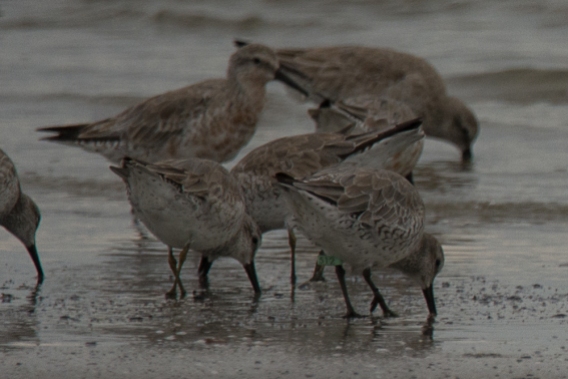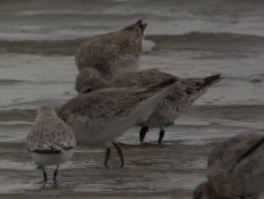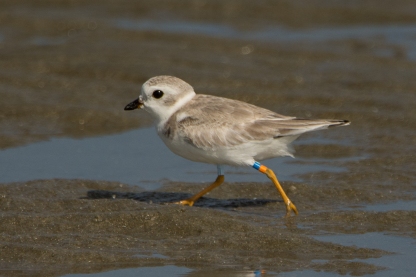Register for one or both of our great events this week!
Where Have All the Shorebirds Gone – Wednesday, March 28, 7:00 pm
SIB bird walk at North Beach with Aija & Ed – Thursday, March 29, 8:30 am
SC DNR has reported seeing over 1000 Red Knots on Deveaux Bank, and the numbers are increasing as they migrate north. Ed and I recently spotted 300 Red Knots about 30 minutes after a high tide. They were feeding on the shore where it bends towards the end of North Beach, one of their favorite spots. A flock of knots was also on a sand bar. As the tide fell, they all moved to the sand bar. As we walked back, we spotted a smaller group of knots in a flock of Willets to the right of Boardwalk #1.
A few knots were beginning to turn reddish. Four had bands, two were readable, #512 and #1C1. In looking at our photos of banded Red Knots, we spotted 1C1 last February too! Per the website to report and track banded birds (bandedbirds.org), 1C1 has also been reported at Kiawah Island in 2012, and at Pawleys Island and Murrells Inlet in 2015 and 2016.
Red Knots have one of the longest migrations of any bird, 18,000 miles round trip from the tip of South America to the Arctic where they breed. From March to early May, Seabrook Island is an important stopping point for them to feed and rest on their long journey north to breed. Last year we had estimated 5000 Red Knots on North Beach at their peak in late April. Knot population on the East Coast has declined 85% since 1980, and they are “Federally Threatened” under the US Endangered Species Act.

Throughout the winter, we usually see Piping Plovers when birding on North Beach. They’re usually in small groups of two to five, feeding along the shore. Some are banded, and we report and send photos of these to biologists at the Virginia Tech Shorebird Program, and University of Minnesota Great Lakes Piping Plover Team, for their research.
We’ve had two recent banded Piping Plover sightings on North Beach that we reported. We learned that one was banded by researchers from State University of NY (SUNY) as a one-day old chick in June 2017, at North Brigantine Natural Area in New Jersey. Ed and I have spotted this Piping Plover twice: this February, and in August 2017 as was migrating south from the Atlantic area breeding grounds.
The second banded Piping Plover we’ve spotted three times: This February, and last November and February. Researchers tell us it was banded on Kiawah Island in 2012, and breeds on the coast of New Jersey. These little guys look to be making themselves right at home as they spend winters with us!
Piping Plovers breed at Great Lakes, Atlantic, and Great Plains areas from April to July. In late July they migrate to southern coasts and the Caribbean to winter until the next spring. Seabrook is an important wintering and migratory site, offering a quality foraging and roosting habitat important for adults to survive and return to their breeding sites. Populations and breeding habitats have drastically declined due to threats of development, people, dogs, predators, weather, and environment. Great Lakes area Piping Plovers are “Federally Endangered”, with only 76 breeding pairs recorded in 2017. Atlantic area Piping Plovers are “Federally and SC Threatened”.
So, look for, and please respect, these endangered and threatened birds that are our guests during their important migration and wintering on North Beach!
Remember our SIB March 28 event, “Where Have All the Shorebirds Gone?”, 7pm Registration & Social, program starts at 7:30pm. Live Oak Hall at the Lake House. Our guest speakers will be Melissa Chaplin, Endangered Species Biologist with the U.S. Fish & Wildlife Services, SC Field Office, and Janet Thibault, Wildlife Biologist with the South Carolina Dept. of Natural Resources. If possible, please RSVP.
Ed and I will lead a SIB bird walk at North Beach to look for the Red Knots, Piping Plovers and other shorebirds on Thursday, March 29. We’ll meet in the Property Owners’ beach parking lot at 8:30am, about an hour after high tide. We’ll be walking to the inlet, and hopefully the knots will begin feeding as the tide falls. RSVP now!
Article by Aija Konrad, Photos by Ed Konrad











